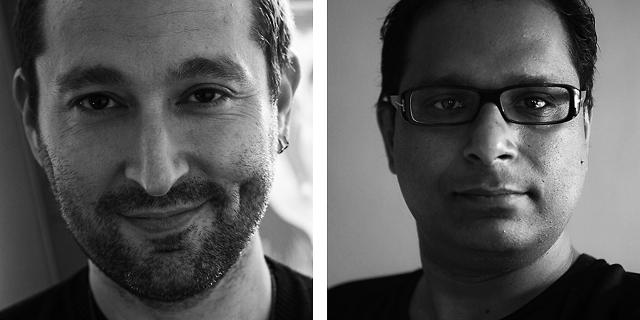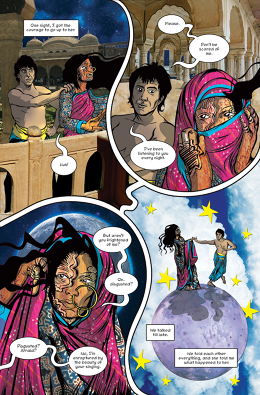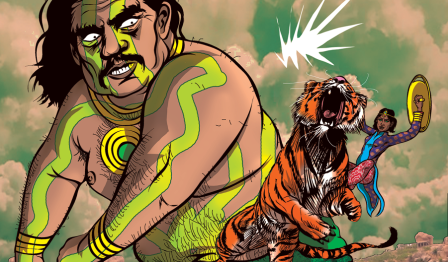Acid Attacks And Augmented Reality: How Priya’s Mirror Is Using Tech To Change India
Pokémon Go has made 2016 an exciting year for augmented reality (AR). The explosive popularity of the app proved the powerful attractiveness of the medium in the gaming sphere. But the creators of Priya, a comic book series about a young Indian woman named Priya who is raped, are proving that AR is ready to take on powerful social issues as well.
Cocreator Ram Devineni, a documentary filmmaker, and Dan Goldman, an illustrator, met at a tech meetup in New York and immediately bonded over a mutual interest in augmented reality. Together they created Priya’s Shakti, the first in the series, which sees Priya recover from her rape and champion women’s rights as a superhero in India with a little help from the powerful Hindu goddess Parvati.
Released in 2012, the timely comic also uses augmented reality filters to engage with readers and reach a broader audience. Now the creators of Priya are back with a sequel, Priya’s Mirror, which addresses the problem of acid attacks in India using storytelling and an AR partnership with the Last Mask Campaign. Users can try on virtual Snapchat filterlike masks that help them empathize with victims of acid attacks, and share them on social media to promote awareness of the issue.
Fresh off an exhibition at the New York Film Festival, Fast Company talked with Devineni and Goldman about Priya, gender violence, and how comic books are an ideal format for teaching children about difficult topics.

I’d love to hear a little bit from both of you about your backgrounds. How did you guys get started with this project?
Ram Devineni: As you probably remember, there was a horrible gang rape on a bus in New Delhi a few years ago, which made international news and caused major protests. And I was involved in those protests and realized that the problem of rape and gender violence was not a legal issue but a cultural problem. So that’s where this idea of creating a comic book superhero named Priya as a way to really educate and talk about gender violence, especially with teenagers, and teenage boys in particular.
Dan Goldman: I’ve been writing and drawing comics, first self-publishing and then creating artwork digitally, for about 15 years. The last couple of those have been on this project. Ram and I met at a tech meetup in New York and literally just bumped into each other and started talking. The more he explained how Priya’s Shakti, the first book, would work and what the shape of it would be, I was just fascinated. I’ve always loved Indian culture and the iconography of Hinduism, the whole vibe of everything. Combining that flavor with activism, it was a sweet spot I didn’t know I had.
Devineni: The place we met was called Story Code NYC. It’s a meetup organized by people who want to do interactive stuff, and I was there, curious about interactive technology, especially augmented reality. And this was two or three years ago, so way before Pokémon Go came out. There were very few people doing anything interesting with augmented reality. Most of it was kind of gimmicky, for marketing and advertising. What Dan and I were really curious about was wanting to use this technology as a form of storytelling, which no one was doing then.
Goldman: Yeah, I recently met the guy who made Pokémon Go and I told him, “Man, we’ve been doing that for years.”
What about comics or graphic novels made them a good medium to tell this story versus, say, a documentary film?
Goldman: It’s something I’ve been playing with in the comics I’ve been creating. I’ve done several politically oriented comic books in the past, and what always seems so effective to me about comics is your ability to present them as entertainment, when in fact it’s educational. There’s an incredible amount of information you can sneak into a comic book and still make it appear as if it’s just for fun. Comics are very subversive in that way, and it’s one of their strengths.
Devineni: Yeah, I mean I should say this, we’re tackling really horrifically subject matters—rape, gang rape, and acid attacks in these two comic books. I think the appeal of the comic book format, especially the way Dan has drawn the artwork to give dignity to the survivors and the characters, has made the comic books very accessible to general audiences, especially teenagers. If you tell someone this is a comic book about gang rape, most people would be very put off by that. But the mere fact that we told the story through the creation of a superhero, especially an Indian female superhero, which is unheard of, and using the context and the structure of Hindu mythology as a way of telling it—it made it appealing to audiences all over.
Goldman: You know, we’re in this trigger warning culture now. And there’s something about presenting these issues in this way, obviously drawn nicely and approached with respect, it seems to step around the trigger and let people actually engage with it and talk about it. Whereas a documentary on the same subject would be very upsetting on either one of the things we’ve tackled.
Devineni: I looked at documentary—it was my initial idea being a documentary filmmaker. But I quickly realized, especially around the time when the news was breaking in December 2012, that a documentary would never go deep into the problem and try to understand it. And then secondly, teenagers and especially Indian teenagers would never watch a documentary. It would turn them off, it’s just not appealing to them. So we understood the audience and figured out that comic books were the best way to reach them, and secondly, adding the augmented reality and interactive technology on top of that, it was just a brilliant idea for teenagers. It’s a perfect synergy of art, activism, and technology designed for young people.

Yeah, I played around with the augmented reality component online. How did you decide on that approach, where people can sort of put themselves in the story?
Devineni: Well we worked with a company called Blippar, and they are one of the biggest AR companies out there. The idea of using AR was to literally turn the comic book into a pop-up book, using a format that is so perfectly designed for AR. It’s visually captivating and it’s multilayered so you can embed videos, interactivity, animation perfectly into a comic book and it seems so natural. And we took it to another level by creating street art, because street art and comic book art fit closely together as well. So we took our characters and created murals all over India, and you can scan those murals and get animation out of it. We used the Blippar app and interface to make everything, and also Blippar worked closely with us in creating more complicated AR. Normally they would charge a ton of money for corporations to use the AR, but in our case they charged us nothing because they understood the beauty of what we were trying to do and the possibility of telling stories.
Does the augmented reality affect the way you think about the artwork as you’re drawing, Dan?
Goldman: For me it’s really that the story has to be complete in the lowest tech version of it because of who our target audience is. Not everybody is going to have a phone or access to broadband, so the entirety of the story has to work on the page. The way we build out the story using the AR is really the bells and whistles for a secondary audience. So what’s in the script needs to be on the page first and foremost, and we have to get all those details and emotions there first, and then we use the AR to animate and bring an extra wow factor to pull in people that have access to that stuff.
Devineni: Well, I agree with Dan to that point, but I’ll also tell a secret that Dan doesn’t know, either. Dan’s artwork, even before he created Priya’s Shakti, is perfectly designed for AR. He is Mr. AR without even knowing it. I try to get him to do his own thing because I know the work he gives us is perfect for AR. And the reason why is he’s one of those few comic book artists who merges comic book art with actual real sceneries and real things surrounding him. The backgrounds are real, they’re photographs, things that exist in the real world . . .

Goldman: Yeah they’re actually collages. I use photography, but I use it in such a way that I’m making fake worlds.
Devineni: Right, fake worlds using photography from the real world. That’s what we’re trying to do with the AR is add that moment of technology, the surreal on top of the real. And if you look at any AR like Pokémon, it is surreal to have this crazy little green dragon running around Central Park with 500 people running around chasing it. It’s a virtual thing, it doesn’t exist, but you make it real by looking through your phone at the app. And that was the whole purpose of working with Dan to make it real. And because the stories are based on women that I’ve interviewed, acid attack survivors and rape survivors, these are actual real people that help form stories. Dan’s artwork works perfectly in sync with that, the real and the fantasy of comic book art.
I’d love to hear more about your research with survivors, especially going into Priya’s Mirror, which focuses on acid attacks.
Devineni: So this all started back in December 2015. I was in Delhi and I met with a group of acid attack survivors through an organization called Stop Acid Attacks. They’ve been on the forefront of trying to change the laws in India. I sat down and interviewed two of them and they told me their stories, and that’s when I realized the problem of acid attacks is so clearly linked with the problem of rape—the social stigma, the cultural isolation, the victim blaming. It happened exactly the same way as it did to the rape survivors I interviewed for the first chapter. We knew we had to make the second chapter about acid attacks.
Goldman: Our “villain” in this story is really interesting, because he’s full of acid, but he’s a victim himself. There’s a very non-black-and-white view of a villain with this character. He’s a survivor of acid attacks himself. The way he treats acid survivors, which appears to be loving and sheltering, is in fact keeping them victims instead of letting them grow beyond their attacks and return to the people they used to be. When the script came in, I was just blown away with this character, he’s so much more than a standard “villain.” He’s a victim himself, just doing what he thought was the right thing but was the wrong thing for a group of women.
What kinds of AR components will be featured in Priya’s Mirror?

Devineni: There’s a lot of pop-up elements, but the one we’re most excited about, that we’re premiering at the New York Film Festival, is something called the Last Mask Campaign. Through the Blippar app you can put on a digital mask, a clear, transparent mask that is slightly disfigured, and you can share it on social media. The idea behind this campaign was started by Natalia, who is an acid attack survivor in Colombia. And she actually sent out physical masks to politicians, to soap opera stars, sports stars in her country, and all of them took photos in the masks and shared them and got a lot of media attention. And it was a way to tell the Colombian people that we need to change the laws in our country because it was very easy to get acid over the counter, and this campaign changed that. The punishment was very little, and this campaign changed that. We wanted to take the spirit of what she was doing in her country and put it into this comic book. She’s also one of the characters in the comic book, I should mention. We want to hopefully create a global campaign where everyone puts on these masks and shares them, they put on these masks so hopefully no one else will have to.
What most excites you about the intersection of augmented reality and social activism and creativity?
Goldman: To me, having been a storyteller for a while, I think I hit a point where I was lacking this organizational component that helps the message land and make actual change in the world. That’s my favorite thing about being a creator of Priya is that I’m seeing things actually manifesting instead of just having fans who are entertained or have their brains bouncing around a little bit with new information. You’re actually watching things changing. That’s what I’ve been looking for my entire career.
Devineni: Yeah, next year we’re going to start a test program with the Lions’ Club to implement the comic book at about a dozen schools in New Delhi. And the possibility of bringing this book as a way to talk about gender violence, especially with young kids and teenagers, is such a blessing and an ideal way for us to move what we’re trying to do forward.
Fast Company , Read Full Story
(42)


